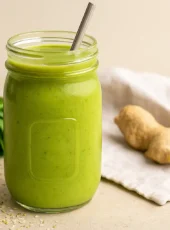Many people live with chronic inflammation without knowing it. This hidden issue is linked to major health problems, but one powerful solution is right on your plate. What you eat can either calm or fuel inflammation in your body.
An anti-inflammatory diet focuses on whole, nutrient-rich foods that help reduce inflammation and improve overall health. It’s not a short-term plan but a long-lasting way to support your body from the inside out.
In this article, you’ll learn what inflammation is, how it affects your health, the best foods to eat and avoid, sample meal ideas, and simple tips to help you get started today.
Understanding Inflammation: Your Body’s Silent Threat
What is Inflammation? (Acute vs. Chronic)
Inflammation is your body’s natural defense against injury or infection. When you get a cut or catch a cold, your immune system triggers a quick response to heal and protect. This is known as acute inflammation. It is short-lived and helpful.
Chronic inflammation is different. It lingers for months or even years. It can happen without any injury or infection. Instead of helping, it quietly damages healthy tissues and organs over time. This slow-burning process can go unnoticed for years and lead to serious health problems if left unchecked.
Diseases and Conditions Linked to Chronic Inflammation
Chronic inflammation plays a role in many long-term health conditions. These include:
- Heart disease
- Type 2 diabetes
- Obesity
- Certain cancers
- Rheumatoid arthritis
- Alzheimer’s disease
- Inflammatory bowel disease
In heart disease, for example, inflammation contributes to the buildup of plaque in arteries, which can lead to blockages. In arthritis, it attacks joints, causing pain and swelling. These examples show how deeply inflammation can affect your health.
What Causes Chronic Inflammation? (Beyond Diet)
Several lifestyle factors can fuel inflammation, including:
- High stress levels
- Poor sleep
- Lack of physical activity
- Exposure to pollution or toxic chemicals
Even though many things contribute, what you eat plays one of the most direct and daily roles. That’s why diet is a key focus when it comes to reducing inflammation and improving health.
What is an Anti-Inflammatory Diet? Principles and Approach
Core Principles of Anti-Inflammatory Eating
An anti-inflammatory diet focuses on whole, natural foods that nourish the body. The goal is to reduce foods that irritate the body and increase those that protect it. Key principles include:
- Choose unprocessed, fresh foods as often as possible
- Eat a variety of colorful fruits and vegetables every day
- Include healthy fats, especially from plant and seafood sources
- Add fiber-rich grains, legumes, and seeds to support digestion
- Avoid sugar-heavy and packaged products
Balance and variety are essential. This approach supports the immune system and helps calm the internal stress that fuels chronic inflammation.
Key Nutrients for Fighting Inflammation
Certain nutrients work naturally to help the body manage inflammation. These include:
Antioxidants
Vitamins like C and E, plus plant compounds like flavonoids and carotenoids, protect cells from stress and damage. They are found in berries, leafy greens, citrus fruits, and nuts.
Omega-3 Fatty Acids
Found in fatty fish like salmon and in flax and chia seeds, omega-3s help reduce the effects of harmful inflammation. They support brain health and heart function too.
Fiber
Fiber feeds good gut bacteria and helps prevent spikes in blood sugar. It also helps the body remove waste. Whole grains, vegetables, legumes, and fruits are great sources.
Polyphenols
These are natural plant chemicals that guard against cell damage. Foods like green tea, berries, olives, and dark chocolate contain high levels of polyphenols. They are powerful helpers in calming the body’s response to stress.
Anti-Inflammatory Foods: What to Embrace
Fruits (Focus on Berries, Cherries, Citrus)
Fruits are packed with vitamins, fiber, and powerful plant compounds. Berries such as blueberries, strawberries, and blackberries are rich in antioxidants that protect your cells. Cherries help reduce muscle soreness and joint pain. Citrus fruits like oranges and lemons offer vitamin C, which supports the immune system and lowers inflammation.
Vegetables (Especially Leafy Greens, Cruciferous, Colorful)
Vegetables provide a wide range of anti-inflammatory nutrients. Leafy greens like spinach and kale are high in vitamins and minerals. Cruciferous vegetables such as broccoli and cauliflower contain compounds that help clear toxins. Bright-colored options like bell peppers and tomatoes offer carotenoids and vitamin C, which protect your cells from damage.
Healthy Fats (Omega-3 Rich and Monounsaturated)
Fatty fish such as salmon, sardines, and mackerel are excellent sources of omega-3s, which lower inflammation and support brain and heart health. Choose wild-caught fish when possible. Extra virgin olive oil is another good fat. Store it in a cool, dark place and use it for salads or low-heat cooking. Avocados, walnuts, flaxseeds, chia seeds, and almonds provide both healthy fats and fiber.
Whole Grains (Oats, Quinoa, Brown Rice, Barley)
Whole grains are rich in complex carbohydrates and fiber. They help control blood sugar levels and support healthy digestion. Oats, quinoa, brown rice, and barley are great choices that can replace white rice or white bread in meals.
Legumes (Beans, Lentils, Chickpeas)
Legumes are rich in plant-based protein, fiber, and minerals. Beans, lentils, and chickpeas help manage blood sugar, feed healthy gut bacteria, and keep you full for longer.
Herbs and Spices (Turmeric, Ginger, Garlic, Cinnamon)
Many anti-inflammatory spices do more than flavor food. Turmeric contains curcumin, which can help reduce joint pain. Ginger aids digestion and lowers muscle pain. Garlic helps the immune system and may reduce blood pressure. Cinnamon can improve blood sugar control.
Beverages (Green Tea, Water, Coffee in Moderation)
Green tea offers antioxidants that protect cells and lower inflammation. Water supports all body functions and helps flush toxins. Coffee, when consumed in moderation, provides antioxidants too. Avoid sugar-filled versions and opt for plain or lightly sweetened options.
Inflammatory Foods: What to Minimize or Avoid
Processed Foods and Refined Grains
Processed foods are often stripped of nutrients and loaded with additives. White bread, pastries, and sugary cereals can spike blood sugar and contribute to inflammation. These foods often contain hidden sugars and unhealthy fats that put stress on your body.
Added Sugars and High-Fructose Corn Syrup
Sugar hides in many packaged items. Sweetened drinks, flavored yogurts, and condiments often contain high-fructose corn syrup. Too much sugar can lead to weight gain, insulin resistance, and chronic inflammation.
Unhealthy Fats (Trans Fats and Excessive Omega-6)
Trans fats are found in margarine, fried foods, and many baked goods. They are linked to heart disease and increased inflammation. Some vegetable oils like corn, soy, and sunflower oil, when used in large amounts, can disrupt the body’s natural balance and promote inflammation.
Red and Processed Meats
Regular consumption of sausage, bacon, and hot dogs is linked to increased inflammation. These meats often contain preservatives and compounds that can irritate the body. Eating too much red meat, especially when charred or heavily processed, can also trigger inflammatory responses.
Dairy Products (for Some Individuals)
Not everyone reacts to dairy the same way. Some people experience bloating or joint discomfort after eating cheese or drinking milk. This could be due to lactose intolerance or a sensitivity to certain proteins in milk.
Artificial Additives and Preservatives
Colorings, flavor enhancers, and chemical preservatives may irritate the gut and disrupt the immune system in sensitive individuals. Reading food labels can help you avoid these hidden triggers.
Popular Anti-Inflammatory Dietary Patterns
The Mediterranean Diet
The Mediterranean diet centers on fresh vegetables, fruits, whole grains, legumes, nuts, olive oil, and moderate amounts of fish. It avoids highly processed foods and added sugars. This way of eating supports heart health and reduces inflammation by providing antioxidants, fiber, and healthy fats.
The DASH Diet
Originally created to lower blood pressure, the DASH diet also lowers inflammation. It focuses on fruits, vegetables, whole grains, low-fat dairy, and lean protein. It limits salt, sugar, and red meat. Many of its principles match those of anti-inflammatory eating, making it a helpful option for overall wellness.
Plant-Based or Vegetarian Diets
Plant-based diets naturally reduce inflammation because they cut out many processed foods and emphasize whole, fiber-rich plant foods. These diets offer a wide range of antioxidants, polyphenols, and nutrients that support gut health and lower stress on the body. For a deeper look, explore our plant-based anti-inflammatory diet guide.
Comparison Table: Mediterranean vs. DASH vs. General Anti-Inflammatory

This table shows that all three styles share a base of whole foods and nutrient-dense ingredients. The general anti-inflammatory diet borrows from both while offering more flexibility based on individual needs.
Practical Tips for Adopting an Anti-Inflammatory Diet
Gradually Transitioning Your Diet
Start with one small change at a time. Swap white rice for brown rice or add a side of leafy greens to dinner. As you include more whole foods, processed options naturally take up less space on your plate. Focus on progress, not perfection.
Meal Planning and Preparation Strategies
Plan your meals ahead to avoid last-minute decisions that often lead to unhealthy choices. Try batch cooking on weekends and use a grocery list based on simple, whole ingredients. Stock your pantry with staples like oats, lentils, canned beans, and olive oil.
Anti-Inflammatory Cooking Methods
Choose methods that keep nutrients intact. Steaming, baking, roasting, and grilling are great options. Avoid deep frying or high-heat cooking with unhealthy oils. Use herbs and spices like turmeric, garlic, and ginger to add flavor and support your health.
Reading Food Labels Effectively
Learn to spot added sugars, trans fats, and artificial ingredients. Look for simple ingredient lists with whole food names. If a product has more than five ingredients or contains things you can’t pronounce, consider finding a better alternative.
Hydration is Key
Water supports digestion, nutrient absorption, and detoxification. Aim to drink water throughout the day. Herbal teas like green tea can offer extra benefits. Try to limit sugary drinks and alcohol, which can stress your system.
Beyond Diet: Lifestyle Factors for Reducing Inflammation
Good food is just one part of the picture. Manage stress through mindfulness or hobbies you enjoy. Get enough sleep to allow your body to repair. Move your body regularly, even if it’s just a short walk. Together, these habits support a calm and healthy system.
Anti-Inflammatory Meal Ideas and Sample Meal Plan
Breakfast Ideas
- Berry smoothie with spinach, chia seeds, and almond milk
- Oatmeal topped with walnuts, flaxseeds, and fresh blueberries
- Whole grain toast with avocado and sliced tomato
Lunch Ideas
- Quinoa salad with roasted vegetables and chickpeas
- Lentil soup with a side of mixed greens and olive oil dressing
- Brown rice bowl with black beans, corn, salsa, and avocado
Dinner Ideas
- Baked salmon with asparagus and a side of sweet potato
- Chickpea curry with brown rice and steamed broccoli
- Stir-fried tofu with kale, bell peppers, and ginger-garlic sauce
Snack Ideas
- Apple slices with almond butter
- A handful of walnuts or pumpkin seeds
- Carrot sticks with hummus
- Unsweetened yogurt with sliced strawberries
Sample 3-Day Anti-Inflammatory Meal Plan
Day 1
Breakfast: Oatmeal with flaxseeds and raspberries
Lunch: Lentil soup with a side salad
Snack: Celery sticks with hummus
Dinner: Grilled trout with roasted Brussels sprouts and quinoa
Day 2
Breakfast: Green smoothie with spinach, banana, and chia seeds
Lunch: Black bean quinoa bowl with avocado
Snack: Almonds and an orange
Dinner: Chickpea stew with brown rice and sautéed kale
Day 3
Breakfast: Whole-grain toast with almond butter and banana slices
Lunch: Mixed greens with grilled chicken, cherry tomatoes, and olive oil
Snack: Sliced cucumber with guacamole
Dinner: Baked tofu with roasted bell peppers and sweet potatoes
This plan offers simple, nourishing meals that are easy to prepare. It provides variety, flavor, and the nutrients your body needs to fight inflammation.
Expert Insights and Resources
What Registered Dietitians Say
Many dietitians agree that an anti-inflammatory diet is one of the most effective ways to support long-term health. According to nutrition experts, focusing on whole foods and avoiding highly processed items can reduce the risk of chronic illness. They often highlight the benefits of eating colorful vegetables, omega-rich fish, and fiber-packed legumes. Some also recommend keeping a food journal to track how certain meals affect your energy, mood, or joint pain.
Here is a sample insight:
“When clients shift to anti-inflammatory eating, they often report more energy and less bloating within a few weeks,” says Sarah Kim, RD. “Even small changes, like adding more greens or switching from sugary snacks to fruit, can make a difference.”
Further Reading and Reputable Sources
To learn more and stay informed, explore these trusted organizations:
- National Institutes of Health (NIH)
- American Heart Association (AHA)
- Academy of Nutrition and Dietetics
- Harvard School of Public Health
- Arthritis Foundation
These sources offer in-depth articles, research studies, and practical advice to help you build a healthy lifestyle that supports your body and mind.
Conclusion
An anti-inflammatory diet is more than just a way of eating. It is a lifestyle shift that supports your body, protects your health, and helps you feel better each day. By focusing on whole foods like fruits, vegetables, healthy fats, and lean proteins, you can calm internal stress and reduce your risk of chronic illness.
This approach does not require perfection. Small, consistent steps make a real difference. Swap processed snacks for fresh produce, cook more meals at home, and drink more water. These changes add up over time.
Remember, you are not just removing harmful foods. You are filling your plate with choices that help you heal, grow stronger, and enjoy more energy.
Start today with one small change. Whether it is adding a handful of berries to breakfast or preparing a healthy dinner, each choice brings you closer to better health.
Make the shift and feel the difference with every bite. Your body will thank you.
FAQ
How long does it take to see results on an anti-inflammatory diet?
Most people begin to notice changes within a few weeks. Energy levels may improve, joint pain may lessen, and digestion can become more regular. However, the exact timeline varies by individual health conditions and how consistently the diet is followed.
Is an anti-inflammatory diet expensive?
It does not have to be. Buying seasonal produce, using frozen fruits and vegetables, and purchasing items like beans, lentils, and grains in bulk can help lower costs. Planning meals ahead also reduces waste and saves money.
Can I eat dairy or gluten on an anti-inflammatory diet?
Some people tolerate dairy and gluten well, while others may react with inflammation. It depends on the individual. If you notice discomfort after eating these foods, consider trying dairy-free or gluten-free alternatives for a period to see if symptoms improve.
Is this diet suitable for weight loss?
Yes, many people lose weight on an anti-inflammatory diet because it focuses on whole, nutrient-rich foods that are naturally lower in calories and high in fiber. The improved digestion and balanced blood sugar also support a healthy metabolism.
Do I need supplements on this diet?
Most nutrients can be obtained from food. However, some people may need supplements if they have deficiencies or special needs. It is best to speak with a healthcare provider before starting any new supplement routine.
Can kids follow an anti-inflammatory diet?
Yes, this way of eating is safe and healthy for all ages. It focuses on real food that supports growth, development, and long-term health. Just be sure meals are balanced and include enough calories and nutrients for children’s needs.







